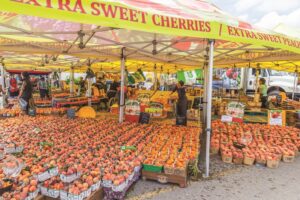LENS technology
NEW NUTRIENT TESTING SYSTEM CONTINUES EVOLVING

“WOULDN’T IT BE GREAT IF …?” That’s likely been the spark behind conversations leading to the creation of new technologies, from systems that plant seed with greater precision to designs that enhance grain handling and analysis.
A new entry in tissue sampling is making waves, from an initial launch in potatoes in New Brunswick three years ago to its gradual spread across Canada and the U.S. The Leaf- Evaluated-Nutrient-System (LENS) unit from Picketa Systems is garnering more attention from agronomists, certified crop advisors (CCAs) and researchers.
After launching the technology in their home province, the team that developed the LENS now have accounts in Ontario and 13 U.S. states, plus the U.K. and Chile. And they’ve accumulated sufficient data to enable the system’s use in corn, which has been a big step.
PUTTING IT TO THE TEST
It’s an accepted drawback that nearly half of nitrogen-based fertilizer applied to crops is effectively used by plants, with the rest lost to the environment. Over-application of fertilizer has been common over the past few decades to ensure crops achieve optimum yields. However, that thought process has been challenged by fertilizer prices that have been higher than five or six years ago, ongoing increases in land and equipment prices, and the impact of the carbon tax.
The LENS technology offers cost-effective nutrient testing that leads to improved efficiency in fertilizer applications, translating into improved performance and higher yields. The system uses reflectance of plant tissue across a wide spectral range – known as “chemometrics” – and feeds the data through machine-learning algorithms. An agronomist or certified crop advisor gathers 10 to 15 samples from a field – with leaves free of visible damage or disease – and scans each leaf with a probe, then clicks a button to submit the sample and retrieve almost- instantaneous results.
“From the initial reports, folks seemed to be impressed with the timeliness of the data, enabling quicker decision-making on nutrient applications,” says Xavier Hébert-Couturier, co-founder and chief executive officer with Picketa Systems. “Our team has been working closely with users to ensure they get the most out of the platform. Overall, we’re hearing a lot of excitement about the potential to use this data to improve long-term nutrient management strategies.”
From a time- and cost-efficiency perspective, LENS eliminates the need to send samples for lab analysis, delivering quick results in the field. In tests with pairs of identical potato samples, the unit consistently returned results with less than five per cent variation for key nutrients such as nitrogen, phosphorous and potassium between pairs. In contrast, lab tests can show more than 20 per cent variation for the same samples.
The LENS system was first tested in potatoes in New Brunswick in 2021, and after three years of working with agronomists and researchers, engineers with Picketa Systems were ready to start with other crops. They worked to calibrate and test the unit in corn for two years, setting up accounts in Illinois, Indiana, Ohio, Minnesota, and nine others. Based on reactions among their new customers for 2024, the decision to evolve into corn was the right one.
“The things we thought would make corn a challenging crop to go into were actually a real positive,” says Hébert-Couturier. “For potatoes, the technology improved an existing process, as most agronomists already send scouts out weekly to take samples. In contrast, corn growers traditionally only performed tissue tests due to specific research needs or yield challenges. With early adopters of the technology, we’re seeing corn growers change their approach, now monitoring their crops more frequently, as with potatoes. The only reason they hadn’t done it before was the lack of a tool that made it feasible.”
Hébert-Couturier and the Picketa Systems team are expanding the unit for canola, which is likely the next major crop added to the platform – with Western Canadian production in mind. They’re still completing field trials and refining the nutrient thresholds for optimal management, but the early feedback and results are promising. Picketa Systems has also added customers in B.C., Alberta, Manitoba and Quebec.
In Ontario, they’ve been working with the University of Guelph on research and with CanGrow Crop Solutions, based near Watford, on sampling for farmers. Staff with CanGrow have gathered more than 600 samples during the 2024 growing season, putting them in the year’s Top 10 most active samplers.
What they liked most was the speed of results, with many growers pleasantly surprised by how quickly they received corn analysis compared to traditional methods,” says Hébert-Couturier. He added that many wanted to see more of their crops supported on the platform.
Haggerty AgRobotics, near Bothwell, is using the unit at the University of Guelph to test wheat.
A “SUITE” ADDITION
Something new for the LENS unit is the Custom Critical Levels feature, which provides agronomists greater control over nutrient management. Traditionally, critical levels, used to assess whether plants have adequate nutrients or are experiencing deficiencies, have been static, broad, and often based on outdated values. Now, the LENS engineers have digitized the process, allowing agronomists to customize nutrient thresholds based on unique field conditions – including soil conditions and weather patterns – as well as crop hybrids or varieties and growth stages.
“For instance, if crops like corn emerge earlier than expected, users can adjust critical levels to align with the actual growth stage, ensuring accurate and timely nutrient management throughout the season,” says Hébert-Couturier. “The designed outcome is to provide more precise and real-time adjustments to fertilizer strategies, improving crop health and optimizing yields.”
Although the LENS platform is simple to use, the economics are unlikely to suit an individual grower; it’s more efficient for agronomists, retailers and researchers to purchase one since they’re scouting and assessing crop health and timing for applications. According to Hébert-Couturier, the break-even for samples is about 250 per season, based on service to 20 different farms. The 1,500-sample mark in 2023 is the highest they’ve seen.
For more information on the LENS technology, go to www.picketa.com/contact. •


























